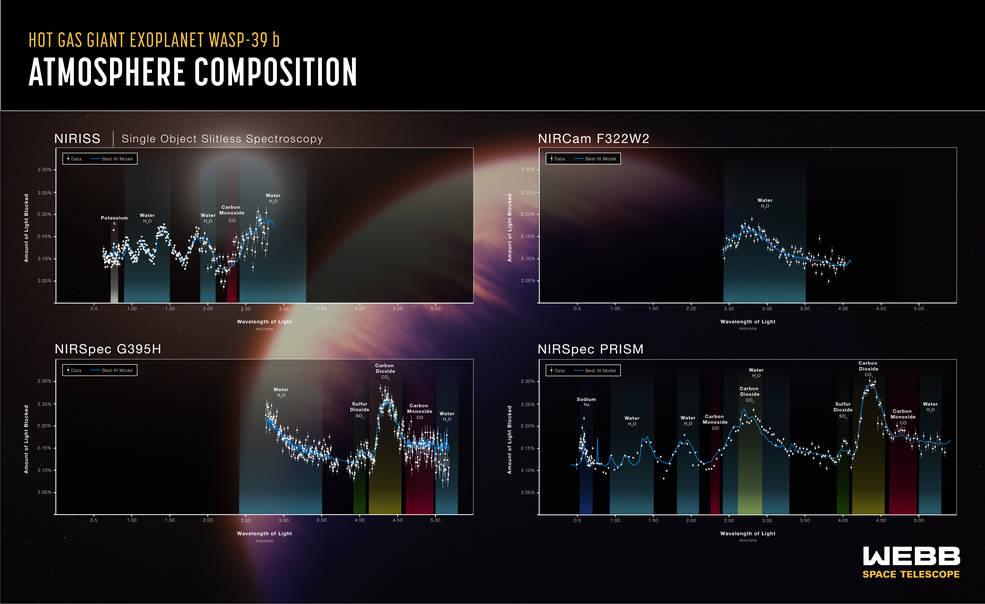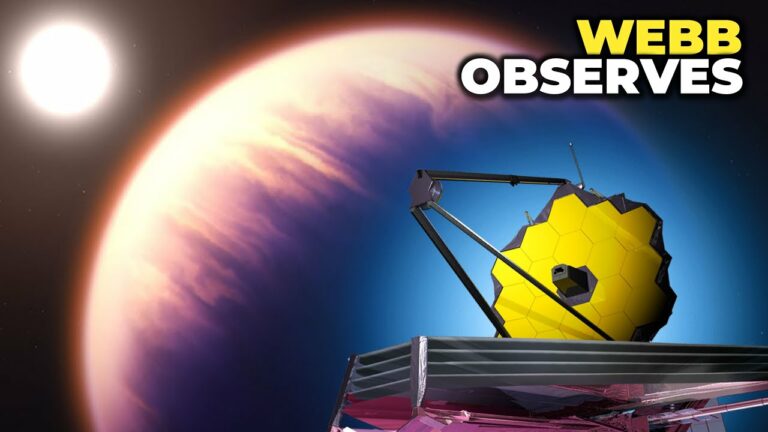James Webb Shows Exoplanet Atmosphere As Never Before
Another first has been achieved by NASA’s James Webb Space Telescope: a molecular and chemical profile of a faraway world’s sky.
The latest readings from Webb show a comprehensive menu of atoms, molecules, and even hints of active chemistry and clouds, in contrast to earlier findings from Webb and other space observatories, such as NASA’s Hubble and Spitzer.
The most recent data also provides an indication as to how these clouds would seem up close: fragmented rather than covering the globe in a single, uniform layer.
The atmosphere of WASP-39 b, a “hot Saturn” (a planet roughly as large as Saturn but in an orbit closer than Mercury), circling a star some 700 light-years away, was the focus of the telescope’s array of very sensitive equipment.
The results are encouraging for Webb’s equipment’ potential to carry out the wide range of examinations of all forms of exoplanets, or planets surrounding other stars, that the scientific community has hoped for. The atmospheres of smaller, stony planets like those in the TRAPPIST-1 system can be probed as part of this.
According to Natalie Batalha, an astronomer at the University of California, Santa Cruz, who contributed to and helped coordinate the new research, “We observed the exoplanet with multiple instruments that, together, provide a broad swath of the infrared spectrum and a panoply of chemical fingerprints inaccessible until [this mission].” “Data like this change the game,”
Five new scientific papers—three of which are under review and one of which is in press—cover the discoveries in depth. One of the ground-breaking discoveries is the discovery of sulfur dioxide (SO2) for the first time in an exoplanet’s atmosphere. This molecule is the result of chemical processes started by high-energy light from the planet’s parent star. Similar processes are used on Earth to produce the protective ozone layer in the upper atmosphere.
The lead author of the paper describing the origin of sulfur dioxide in WASP-39 b’s atmosphere, Shang-Min Tsai, a researcher at the University of Oxford in the United Kingdom, said, “This is the first time we see concrete evidence of photochemistry – chemical reactions initiated by energetic stellar light – on exoplanets.” I think [this project] has a tremendously bright future for expanding our knowledge of exoplanet atmospheres.
Another first as a result of this was the use of photochemistry computer models to data that necessitates the complete explanation of such physics. The ensuing advancements in modeling will contribute to the development of the technological know-how necessary to decipher future indications of habitability.
Planets circling beneath the host star’s radiation bath are “sculpted and reshaped,” according to Batalha. “Those changes on Earth enable life to flourish.”
Eight times closer to its host star than Mercury is to our Sun, the planet serves as a testing ground for the effects of radiation from host stars on exoplanets. Improved comprehension of the star-planet relationship should lead to a deeper comprehension of how these processes impact the variety of planets seen in the galaxy.
Webb followed WASP-39 b when it crossed in front of its star, enabling part of the star’s light to get through the planet’s atmosphere and allowing for the detection of light from the object. Astronomers may identify the molecules by looking at the colors that aren’t there because various kinds of compounds in the atmosphere absorb different hues of the starlight spectrum. Webb can detect chemical fingerprints in the universe that are invisible to the human eye by observing it in infrared light.
Other atmospheric components identified by the Webb telescope include sodium (Na), potassium (K), and water vapor (H2O). These results were confirmed by earlier space and ground-based telescope investigations, and new fingerprints of water were discovered at these longer wavelengths.
Additionally, Webb saw carbon dioxide (CO2) with double the precision of its prior observations, yielding more information. In the meanwhile, carbon monoxide (CO) was found, but the Webb data lacked any detectable methane (CH4) or hydrogen sulfide (H2S) signs. If present, these compounds are only found in extremely small amounts.
An international team of hundreds independently analyzed data from four of the Webb telescope’s finely calibrated instrument modes to capture this wide spectrum of WASP-39 b’s atmosphere.

Credits: NASA, ESA, CSA, J. Olmsted (STScI)
According to Hannah Wakeford, an astronomer at the University of Bristol in the United Kingdom who studies exoplanet atmospheres, “we had projected what [the telescope] would show us, but it was more precise, more diversified, and more beautiful than I actually imagined it would be.”
An exoplanet’s atmosphere has such a comprehensive list of chemical constituents that it also provides scientists with information on the abundance of certain elements in relation to one another, such as carbon-to-oxygen or potassium-to-oxygen ratios. This in turn sheds light on how this planet—and maybe others—formed from the ring of gas and dust that surrounded the parent star when it was still a young star.
The chemical makeup of WASP-39 b points to a history of collisions and mergers between planetesimals, or smaller worlds, to form a final goliath of a planet.
According to Kazumasa Ohno, an exoplanet researcher at UC Santa Cruz who worked on the Webb data, “the abundance of sulfur [compared to] hydrogen suggested that the planet apparently had extensive accretion of planetesimals that may supply [these elements] to the atmosphere.” The statistics also show that the abundance of oxygen in the atmosphere is far greater than that of carbon. This would suggest that WASP-39 b developed initially far from the main star.
The Webb telescope’s equipment performed much above scientists’ expectations in precisely parsing an extraterrestrial atmosphere, and they signal a new era of study amid the wide diversity of exoplanets in the galaxy.
As a member of the international team and a researcher at Cornell University, Laura Flagg remarked, “We are going to be able to glimpse the overall picture of exoplanet atmospheres.” Knowing that everything will be redone is really exciting. One of the nicest things about being a scientist is that.
The best space scientific observatory in the world is the James Webb Space Telescope. In addition to looking beyond our solar system to distant planets orbiting other stars, Webb will delve into the enigmatic architecture and origins of the cosmos and our role within it. Webb is a global initiative run by NASA in conjunction with the Canadian Space Agency and the European Space Agency (Canadian Space Agency).
Source:NASA
Do not forget to share your opinion with us to provide you with the best posts !




0 Comments